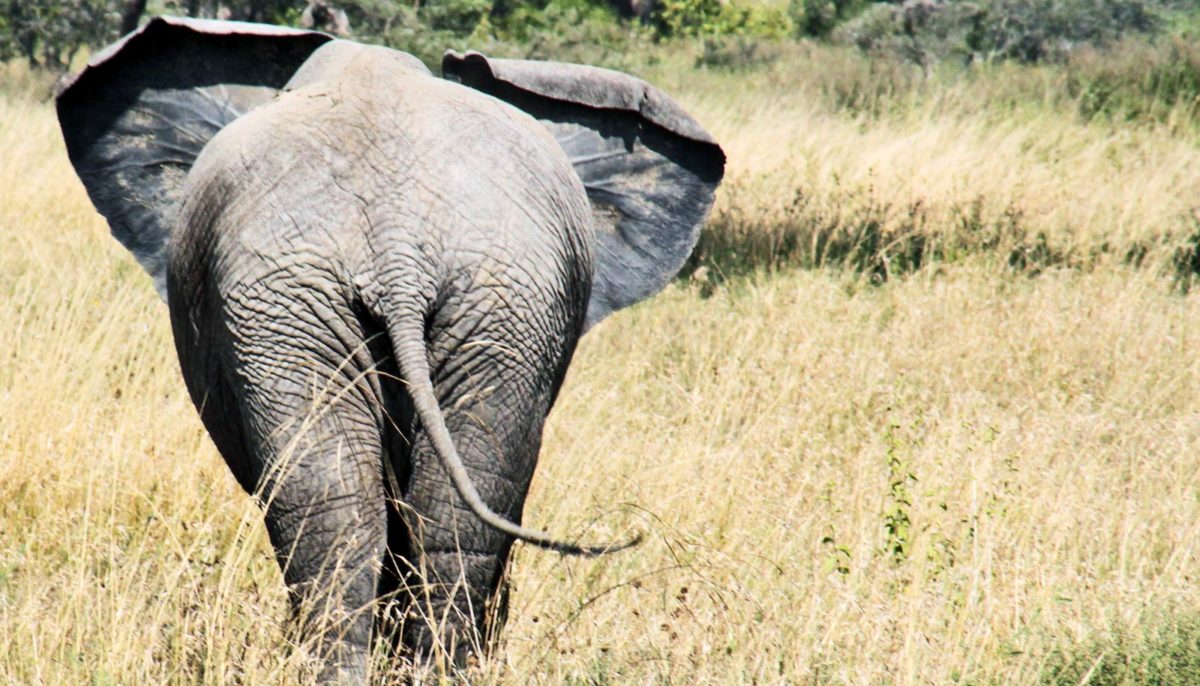The elephant is the largest land mammal on the planet. Weighing in at two to six tons, they are taller than most other land mammals and can outrun most predators.
So why do these big animals have such a small tail?
It acts as a barrier between the predator and elephant
The small tail is in fact a very large extension to the normal, low set of hairs at the end of an elephant’s rump, showcasing a unique aspect of their anatomy.
When threatened or when there are predators around, the tube like structure may be dropped by flicking it down with their back legs.
This then forms a barrier between the predator and hapless elephant’s hind legs and back end.
The tail is also used for the same purpose in the wild, by flicking it down to form a barrier between them and their predators or other animals that may try to attack them.
Elephants also use their tail to communicate with each other
Much like a dog, elephants also use their tail to communicate. A swishing or wagging tail can signify happiness or excitement.
Baby elephants sometimes hold on to the tail of older elephants while they are walking, for guidance and security on long walks.
Elephants use their tail as a signal for danger by raising it up in the air and waving it around quickly. This warns other elephants to take cover and stay away from the danger.
Elephants also use their tails to cool themselves down from the heat
To keep cool in the hot African savanna, African elephants have been known to spray water from nearby rivers onto their backs and then flick around their tail to help evaporate the liquid. This allows them to stay hydrated by releasing liquid through evaporation.
In areas where there is little water, elephants can also use their tail to flick around sand onto them and smear it on themselves for protection against the sun.
The tail is used to protect the elephant skin from flies and other bugs
The tail full of hair also works as a flyswatter, to help keep away those annoying and biting flies.
An elephant’s tail is also used much like a broom to sweep away pesky bugs or pests that might try and attack them.
It’s all an act for keeping balance
While at first glance, the elephant’s tail is quite unimpressive, elephants rely on their tail to keep balance.
If the tail is facing downwards while standing on all four legs, it provides a counterbalance to stand on. If the tail is turned upwards, this also acts as a support when the elephants are standing on their hind legs.
The elephant’s tail really comes into its own when they are sitting down or even lying down. The tail then helps these large animals to balance and also to push themselves up again.
It can be used as an extra limb to reach
The tail is used as an extra limb when the elephant needs to reach something too high or low to reach with just their trunk. This helps to prevent them from getting hurt by allowing them to use their tail as an extra limb.
When the elephant is lying on the ground, they are more likely to use this extra ‘arm’ to help themselves up again rather than using their back legs which can be quite powerful and potentially dangerous if used incorrectly.
FAQ on elephants tails
An elephant’s tail is used for many purposes. It acts as a barrier when predators are near, it can help them to stay cool in the hot African sun and it helps to swat away pesky bugs. Elephants also use their tails for balance, communication and even an extra limb when they need one.
Yes, an elephant has a long skinny tail which is usually hidden beneath a layer of thick hair at the end of their rump. When they want to use it, elephants flick it down to provide cover from predators.
An elephant’s tail is short because it generally isn’t needed for much else other than balance. There are, however, some occasions where an elephants could use their tail to swat away bugs or help them stay balanced when standing up.
Elephant tails can vary greatly in length, though they are generally between one and two meters long.
An elephant’s tail is covered in thick hair when they are young to help protect them from the African sun and keep them warm. When they get older, their tails become thinner and more sparse in order for them to be useful as a flyswatter or an extra limb.
An elephant’s tail has a very distinct smell which can be anything from pungent to musky.

One reply on “Why do Elephants have a small tail?”
[…] Quote from the source: … […]